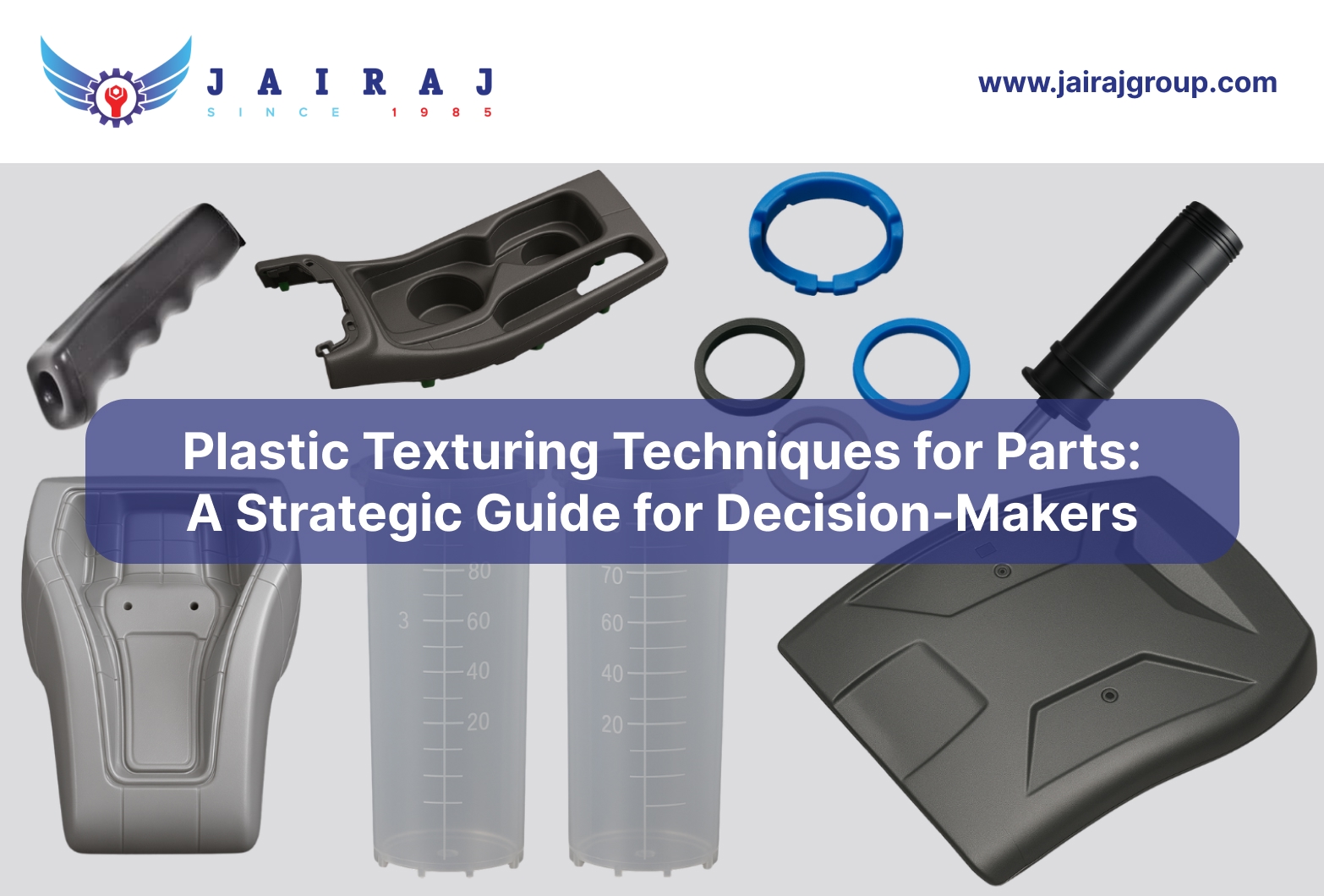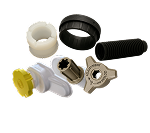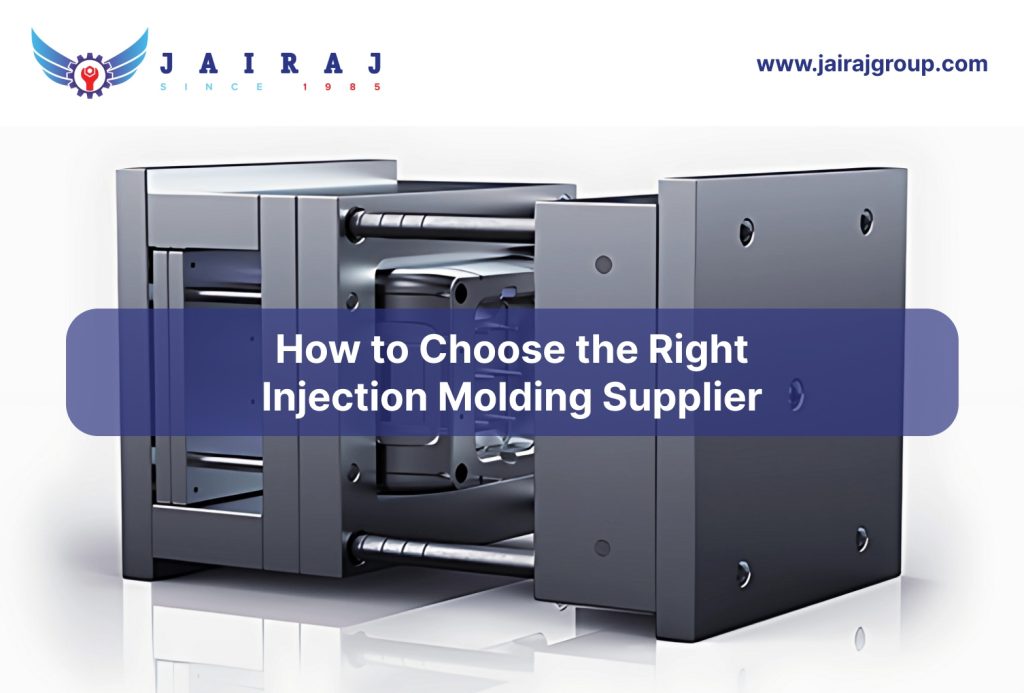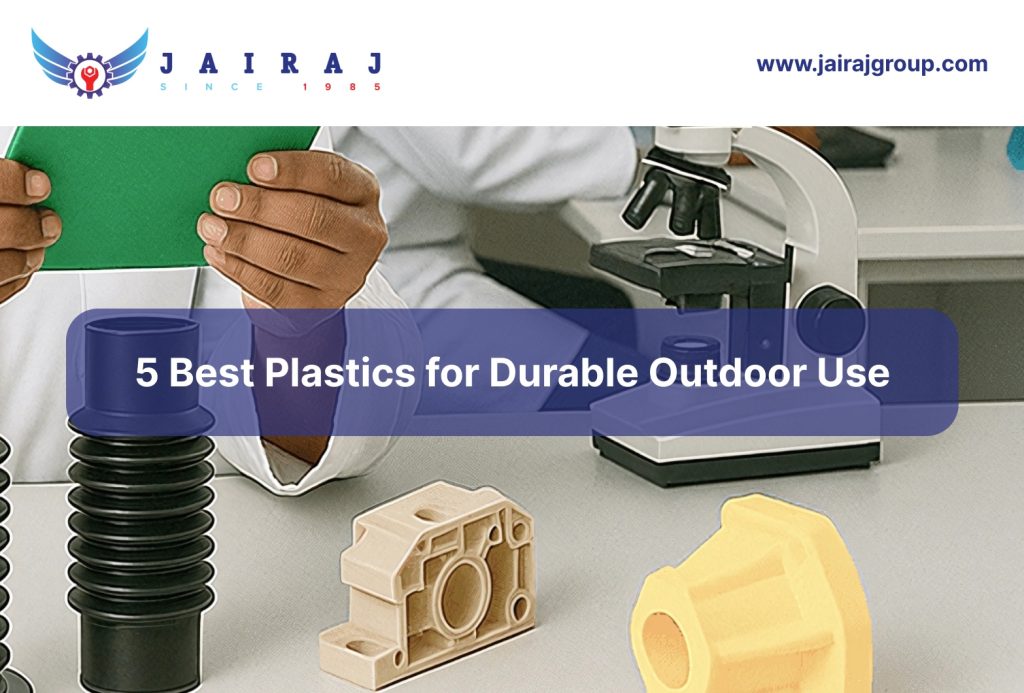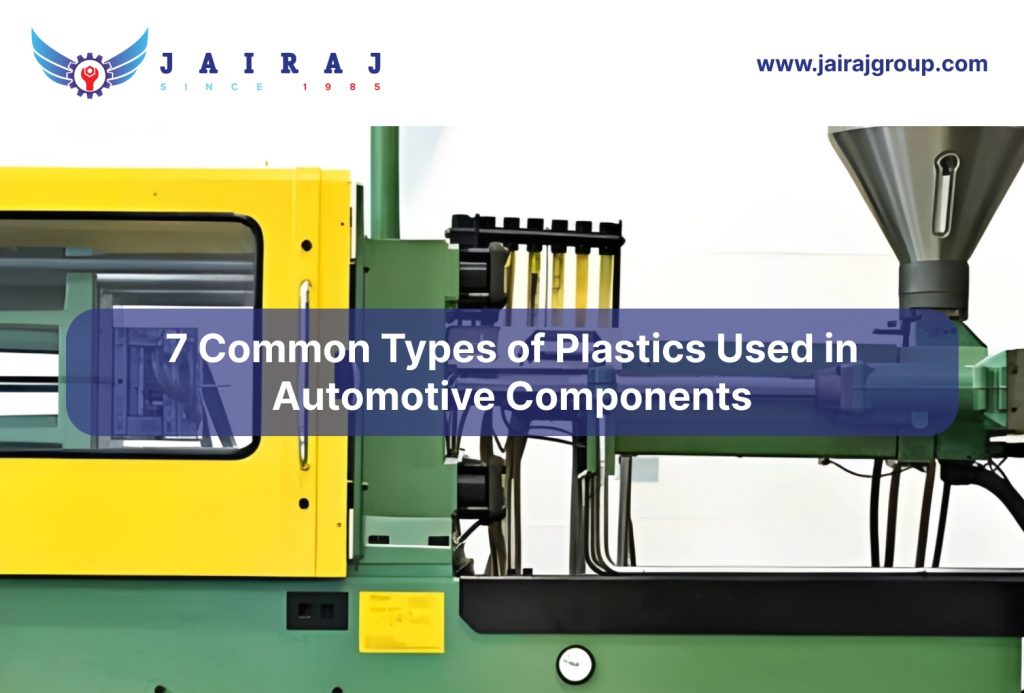In manufacturing, plastic mold texturing is no longer a cosmetic afterthought, it’s a strategic lever. The texture applied to plastic parts directly affects brand perception, compliance, ergonomics, and even cycle times.
For procurement and category leaders, it impacts Total Cost of Ownership (TCO) by reducing post-processing. For engineering managers, it raises Design for Manufacturability (DfM) challenges. And for quality teams, it must align with IATF 16949, PPAP, and OEM-specific standards.
The stakes are high. A misstep in texturing can create launch delays, revalidation loops, or field-quality issues, risking both revenue and program timelines.
This article lays out how to approach plastic texturing decisions strategically to minimize risk and strengthen supply chain resilience.
Key Takeaways
Well-executed mold texturing eliminates costly post-processing, accelerating time-to-market.
Early DfM alignment between design and tooling teams reduces risk of nonconformance and mold rework.
Standardized texture specifications simplify supplier qualification and PPAP documentation.
Emerging digital techniques enable brand-specific differentiation while controlling cost and complexity.
To understand which techniques and processes to prioritize, it is first necessary to see why plastic texturing has become critical.
Why Plastic Texturing Matters Today?
The global industrial mold market, encompassing plastic mold texturing, was valued at approximately USD 54 billion in 2024 and is projected to reach USD 119.73 billion by 2033, growing at a CAGR of 9.25%. This growth highlights the increasing importance of mold texturing in various industries.
As a result, plastic texturing can no longer be treated as a black-box activity by procurement heads and program managers. It requires structured oversight, clear decision frameworks, and proactive collaboration to achieve consistent results.
Plastic mold texturing has evolved from a mere esthetic consideration to a critical component influencing product quality, brand identity, and operational efficiency. This shift is driven by:
Brand differentiation: Consumers increasingly demand unique, high-quality surfaces that provide consistent visual and tactile appeal. Achieving this requires precise and repeatable texturing processes.
Compliance and cost pressures: Regulatory standards such as ISO 9001 and IATF 16949 necessitate strict process control and traceability.
Concurrently, procurement teams strive to balance quality with cost efficiency, considering factors like scrap rates and tooling adjustments.
Minimize plastic texturing risks with suppliers offering in-house laser and chemical etching, SPI/VDI-compliant depth control, and complete post-texture finishing. JaiRaj Group ensures Class-A surface validation and functional compliance to keep your programs on schedule.
Align your texturing strategy with quality and timelines by contacting JaiRaj Group.
Before choosing a supplier or finalizing tooling strategies, it’s critical to understand how different texturing methods affect costs, timelines, and risk.
Core Plastic Texturing Techniques: What Leaders Need to Evaluate
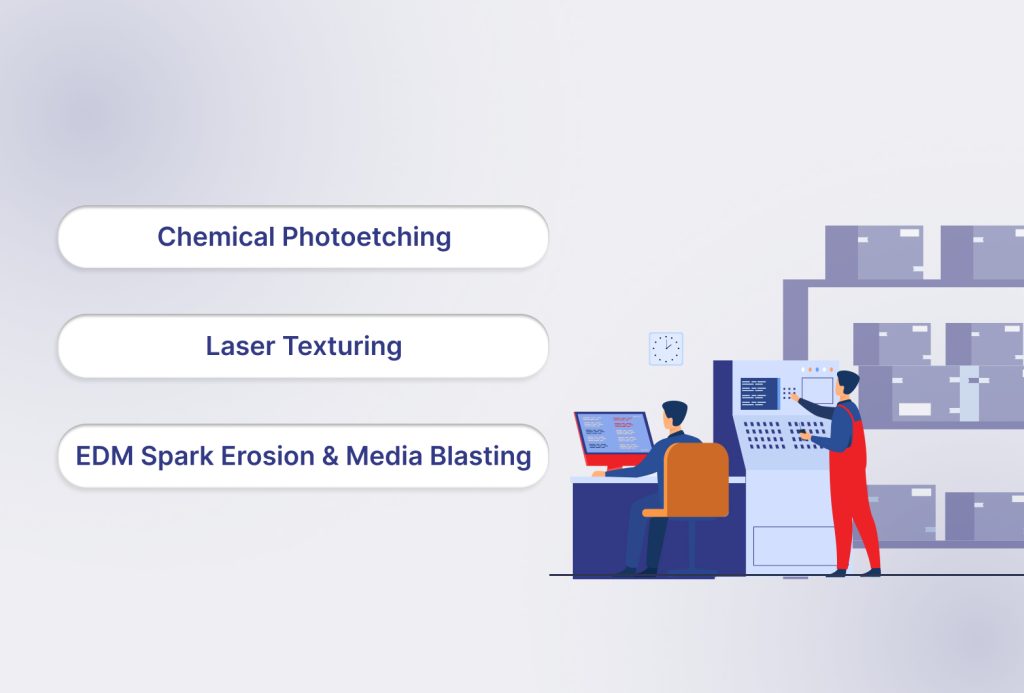
For leaders in aerospace, defense, heavy equipment, and white goods, mold texturing is more than an esthetic choice, it directly impacts tooling cost, cycle time, quality approval risk, and program continuity.
Selecting the right plastic texturing method requires balancing upfront investment with long-term part performance and supplier capability.
Key plastic texturing techniques to evaluate include:
1. Chemical Photoetching
Chemical photoetching applies a photoresist mask, followed by ferric chloride or nitric acid to etch patterns into the mold cavity.
Ideal for: Consistent, repeating textures such as grains, stipples, or fine surface patterns.
Benefits: Economical, proven technology, widely available among suppliers.
Impact: Reduces upfront tool costs by 15–20% vs. laser for repeating textures but carries a 2–4 week approval risk if depth control issues occur.
Program Risk: Challenging for complex 3D surfaces; may require third-party coordination, impacting supplier agility.
Strategic Recommendation: Use for non-critical surfaces or where suppliers have proven, repeatable capabilities. Dual-source to mitigate downtime risk.
Also read: Precision Components from Advanced Polymers for Automotive and Aerospace Applications
2. Laser Texturing
Laser texturing uses CNC-controlled lasers guided by 3D CAD models to burn patterns directly onto the mold.
Ideal for: Custom brand textures, micron-level precision, and complex geometries.
Benefits: High accuracy, repeatable results, flexible design options, minimal rework.
Business Impact: High upfront investment compared to photoetching, but reduces rework and scrap by 25–30%, accelerating part approval cycles.
Program Risk: Requires skilled operators and precise tool maintenance; supplier footprint matters for schedule adherence.
Strategic Recommendation: Reserve for Class-A dashboards, esthetic trims, and branded components where speed-to-market and differentiation justify investment.
3. EDM Spark Erosion & Media Blasting
Electrical Discharge Machining (EDM) creates micro-pitting for matte finishes, while media blasting (glass beads or sand) achieves uniform roughness.
Ideal for: Non-critical surfaces where texture consistency is less stringent.
Benefits: Cost-effective, fast turnaround, simple process.
Business Impact: Low-cost, fast-turnaround solution for secondary or non-critical surfaces; limited pattern variety can increase inspection touchpoints.
Program Risk: Operator-dependent; inconsistent texture can trigger rework.
Strategic Recommendation: Suitable for secondary interiors or functional surfaces; avoid on visible or regulatory-critical parts.
Ensure Class-A surface quality and minimize rework by working with JaiRaj Group’s in-house laser and controlled photoetching capabilities through Tailored plastic polymer engineered solutions, backed by multi-site production and ISO/IATF-certified processes to keep program timelines on track.Standards, Specifications, and DfM Alignment.
Next, understanding the potential pitfalls of texturing is essential before committing to tooling or suppliers.
Risk Assessment: How Plastic Texturing Can Impact SOP
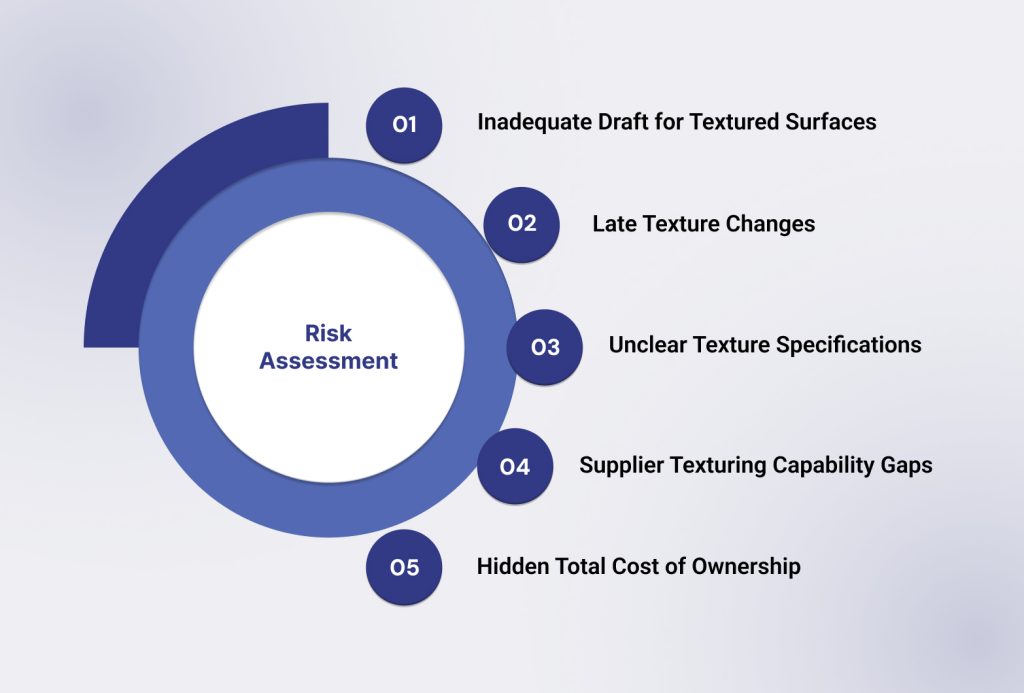
Even small issues with plastic surface texture can ripple through a program, delaying launches and increasing costs. To prevent costly disruptions, leaders need to recognize where problems typically arise and take proactive measures.
Key areas of concern include:
1. Inadequate Draft for Textured Surfaces
Textured parts require sufficient draft angles. Insufficient draft can cause parts to stick in the mold, leading to ejection marks, surface defects, or even mold damage.
Mitigation: Validate draft angles during DfM reviews and confirm supplier capability for texture-specific design requirements.
2. Late Texture Changes
Changing the texture late in the program often triggers steel weld repairs or tool modifications, delaying mold qualification by weeks and increasing cost.
Mitigation: Lock texture specifications early in the RFQ stage and integrate texture feasibility checks into supplier approvals.
3. Unclear Texture Specifications
Ambiguous or incomplete texture specs can lead to supplier interpretation errors, resulting in inconsistent plastic surface texture, poor visual quality, or PPAP rejections.
Mitigation: Standardize mold texture requirements using SPI or VDI references and require sample plaques for approval before production.
4. Supplier Texturing Capability Gaps
Reliance on third-party texturing or inexperienced suppliers increases the risk of inconsistent mold texture, leading to scrap, rework, or delayed SOP.
Mitigation: Partner with suppliers that demonstrate in-house expertise in laser, chemical, or EDM texturing, supported by SPC data on texture depth and gloss consistency.
5. Hidden Total Cost of Ownership
Surface defects, rework, and texture-related delays add unexpected costs that are often overlooked in unit pricing, eroding program budgets and timelines.
Mitigation: Evaluate total cost of ownership including tooling, texturing process, rework risk, and supplier governance rather than focusing solely on per-part price.
Takeaway: Executives who anticipate these risks by implementing a texture feasibility checklist at the RFQ stage and require suppliers to submit sample plaques of proposed textures for approval.
After understanding risks, it is equally important to consider post-texturing finishing.
Also read: Plastic Injection Molding: Precision Thermoplastic Components
Post-Texturing Finishing: A Hidden Cost Driver in Plastic Components
For OEMs and Tier-1 suppliers, mold texturing and post-texture finishing significantly affect part quality, cycle time, and total cost of ownership.
Materials such as polypropylene (PP), ABS, PC/ABS, nylons (PA6, PA66), PBT, and TPEs behave differently during texturing and finishing, making supplier capability critical.
To ensure program success, procurement leaders should pay attention to the following key areas:
1. Surface Preparation and Sandblasting
Before production begins, controlled sandblasting and residue cleaning set the stage for a consistent plastic surface texture.
This step prepares Class-A surfaces for glossy finishes and prevents defects in the injection mold texture, which could otherwise lead to rework during PPAP validation.
2. Release and Cycle Time Management
Material-specific behaviors, such as PP or PC/ABS sticking in molds, can increase cycle times if draft angles or texture of plastic are not properly accounted for. Early evaluation helps mitigate bottlenecks and ensures smoother production runs.
3. Appearance Consistency
Even minor variations in mold texture across parts can trigger OEM complaints. Post-texturing finishing guarantees uniformity for dashboards, trims, and visible interiors, protecting program timelines and brand perception.
4. Inspection and Quality Validation
To avoid downstream issues, suppliers should submit finishing and inspection plans with PPAP documentation. Verifying plastic texturing depth and uniformity ensures quality compliance and reduces risk of delayed launches.
Once processes and finishing requirements are clear, the next step is aligning supplier capabilities with part criticality.
Aligning Supplier Strengths with Critical Plastic Surface Needs
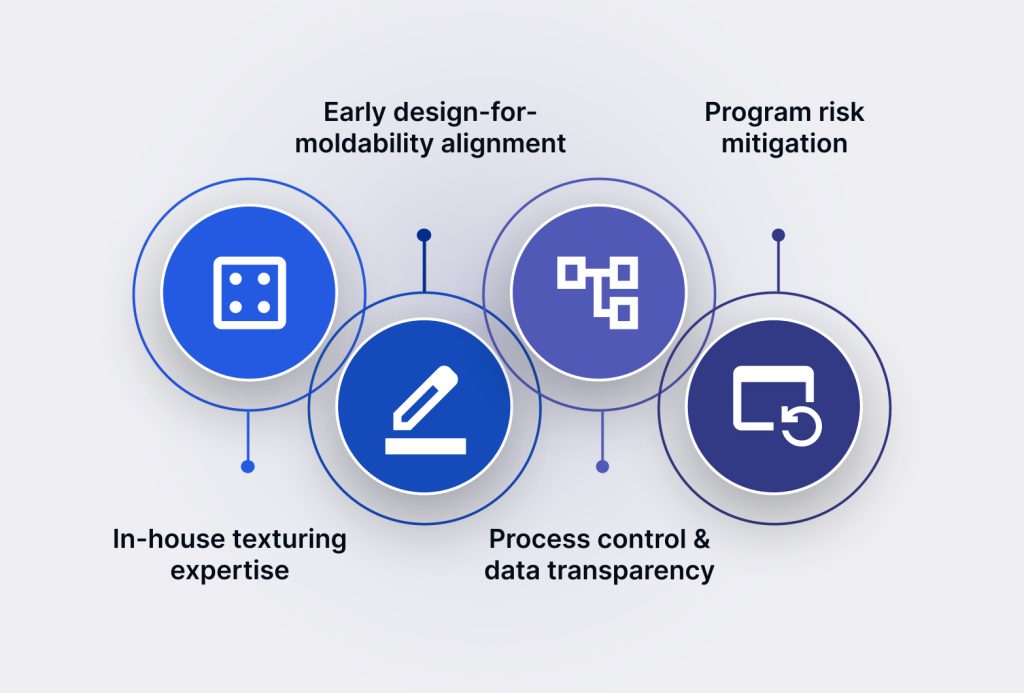
For OEMs, Tier-1 suppliers, and program managers, mold texturing capability is a key marker of supplier maturity. Choosing the right partner reduces texture-related launch risks, ensures part quality, and keeps programs on schedule.
JaiRaj Group integrates mold texturing into strategic sourcing across four critical levers:
1. In-house texturing expertise
JaiRaj works with certified partners capable of laser and chemical etching. By combining in-house capability with controlled third-party support, the group delivers consistent injection molding texture and plastic surface texture for Class-A parts across multiple applications.
Key products include:
2. Early design-for-moldability alignment
Texturing considerations are built into the RFQ stage and initial DfM reviews. Early alignment reduces tool rework, accelerates PPAP approval, and keeps program timelines intact. Products benefiting from this include Plastic Bellows & Struts and Precision Components from Advanced Polymers.
3. Process control and data transparency
Procurement teams can access SPC data on mold texture, depth, gloss consistency, and surface repeatability. This ensures that the texture of plastic parts meets specifications, reducing audit risk across high-stakes programs, including defense, aerospace, and heavy equipment.
4. Program risk mitigation
By mapping supplier capabilities to part criticality, JaiRaj ensures that high-visibility surfaces receive the appropriate injection mold texture method, avoiding rework and third-party delays while maintaining total cost of ownership.
With over 35 years of manufacturing expertise, multiple certified facilities across Faridabad, Manesar, Aurangabad, Sanand, and Rudrapur, and a broad product portfolio spanning automotive, EVs, heavy equipment, white goods, aerospace, defense, railways, drones, and solar.
JaiRaj Group enables procurement leaders to make informed sourcing decisions that protect timelines, cost, and quality.
Also read: Top Plastic Manufacturers in 2025
Conclusion
Plastic mold texturing can be a hidden risk or a competitive advantage. When managed proactively, it improves brand perception, accelerates PPAP approvals, and lowers TCO by removing post-processing steps.
For procurement, quality, and engineering leaders, the mandate is clear: pull texturing decisions forward in the program timeline and tie them to supplier evaluation criteria.
If you’re planning new tooling or re-sourcing molded parts, connect with JaiRaj Group to evaluate texturing readiness during RFQ. This small step can save weeks during SOP and protect millions in program investment.
FAQs
1. How early should plastic texturing be discussed in new part development?
Plastic texturing should be addressed during initial DfM reviews, before steel cutting. Early alignment on injection mold texture avoids costly tool rework, surface defects, and program delays, ensuring PPAP approval and launch timelines remain on track.
2. What is the cost impact of advanced laser injection molding texture?
Advanced laser texturing requires a higher upfront investment. However, it reduces scrap, rework, and launch delays. Evaluating suppliers on total cost of ownership, including tooling, process control, and mold texture consistency, shows that this approach often lowers program-level costs over the lifecycle.
3. Which standards should be used for plastic surface texture specifications?
SPI and VDI standards are widely accepted for plastic surface texture. Including them on drawings and PPAP documentation ensures suppliers meet injection mold texture requirements, reducing audit rejections and surface-quality disputes.
4. How do I assess if a supplier can handle complex mold texturing?
Review suppliers’ in-house versus outsourced mold texturing capabilities, past Class-A part examples, and process control data. Mature suppliers with integrated R&D, tooling, and quality governance reduce program risk and maintain consistent texture of plastic parts.
5. Can improper mold texture cause part rejection at OEM audits?
Yes. Poor mold texture can result in inconsistent gloss, release issues, or visible defects, which can trigger rejections. Aligning texturing method to part criticality and choosing suppliers with proven in-house capabilities mitigates risk and ensures program continuity.

